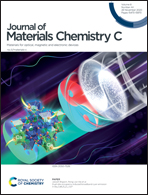Intramolecular H-bond design for efficient orange–red thermally activated delayed fluorescence based on a rigid dibenzo[f,h]pyrido[2,3-b]quinoxaline acceptor†
Abstract
High-efficiency orange and red thermally activated delayed fluorescent (TADF) organic light-emitting diodes were fabricated based on a pair of isomers 3,6,11-triAC-BPQ and 3,6,12-triAC-BPQ, containing a rigid dibenzo[f,h]pyrido[2,3-b]quinoxaline (BPQ) core and three 9,9-dimethyl-9,10-dihydroacridine (Ac) donors. Both materials exhibited red emission in neat films and small singlet–triplet energy gaps. Compared with the stable intramolecular charge transfer (ICT) state of 3,6,12-triAC-BPQ, 3,6,11-triAC-BPQ showed hybridized local and charge transfer (HLCT) character due to the H-bond between the 11-position Ac and 10-position N atom. As a result, the doped film of 3,6,11-triAC-BPQ showed a high photoluminescence quantum yield (PLQY) and the related device showed a high external quantum efficiency (EQE) of 22.0% in the orange–red region.
![Graphical abstract: Intramolecular H-bond design for efficient orange–red thermally activated delayed fluorescence based on a rigid dibenzo[f,h]pyrido[2,3-b]quinoxaline acceptor](/en/Image/Get?imageInfo.ImageType=GA&imageInfo.ImageIdentifier.ManuscriptID=D0TC03965A&imageInfo.ImageIdentifier.Year=2020)


 Please wait while we load your content...
Please wait while we load your content...